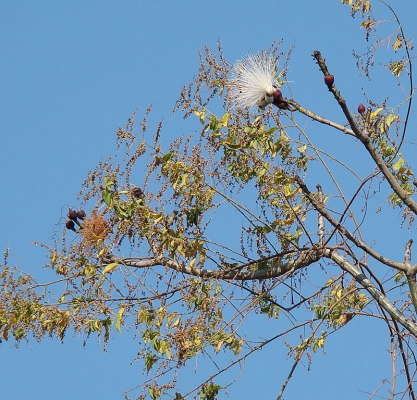Bombacopsis sessilis
(Benth.) Pittier
Malvaceae
There is still doubt about the correct name for this species, and there is a strong possibility that it will be transferred to the genus Pachira as Pachira sessilis Benth.[
K- Title
- Plants for a Future
- Author
- Ken Fern
- Description
- Notes from observations, tasting etc at Plants For A Future and on field trips.
].
Bombax sessile (Benth.) Bakh.
Pachira angusta Duchass. ex Decne.
Pachira sessilis Benth.
Common Name:

Flowering stems
Photograph by: Dick Culbert
Creative Commons Attribution 2.0
General Information
Bombacopsis sessilis is a deciduous tree growing 20 - 25 metres tall. The bole is cylindrical, though bent and often inclined, and can be 60cm in diameter. At its base, the bole develops small but distinct buttress roots that meld with it at a height of about one metre. Branches are relatively few in number, stout, and haphazardly arranged, yielding a thin, somewhat narrow, asymmetrical crown[
].
The tree is harvested from the wild for its fibre and edible seeds, which are used locally.
Known Hazards
None known
Botanical References
502- Title
- Contributions from the United States National Herbarium Vol. 18
- Publication
-
- Author
-
- Website
- http://www.biodiversitylibrary.org
- Publisher
- Smithsonian Institute; Washington.
- Year
- 1917
- ISBN
-
- Description
- Includes a treatment of the Annona. It can be downloaded from the Internet.
Range
Central America - Panama, Costa Rica.
Habitat
Grows almost exclusively in sandy soils and in near proximity to the ocean, often forming small stands[
].
Properties
| Edibility Rating |      |
| Other Uses Rating |      |
| Habit | Deciduous Tree |
| Height | 22.00 m |
| Pollinators | Bats, Moths |
| Cultivation Status | Wild |
Cultivation Details
Not known
Edible Uses
Seed[
]. They are said to be especially good toasted[
].
Medicinal
None known
Agroforestry Uses:
Bromeliads and other epiphytic plants are commonly found attached to the branches due to the openness of the tree's crown and the large amounts of insolation that penetrate it. This is even more true during the dry season when no foliage is present to obstruct the sun[
].
Other Uses
The cottony fibre found in the seedpods can be used as insulation, stuffing for toys, pillows etc, or as a filler for upholstery[
].
The wood is light and little used[
].
Propagation
Seed - germination in the wild takes places immediately the seeds have been released and made contact with moist soil - or, if the weather is still dry, they await the arrival of the rainy season[
]..
If you have any useful information about this plant, please leave a comment. Comments have to be approved before they are shown here.
 Useful Tropical Plants Database 2014 by
Ken Fern,
web interface by
Ajna Fern
with help from
Richard Morris.
Useful Tropical Plants Database 2014 by
Ken Fern,
web interface by
Ajna Fern
with help from
Richard Morris.